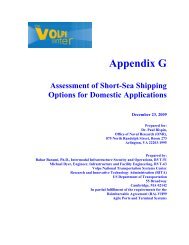Container-on-Barge Pre-Feasibility Study Final Report - Towmasters ...
Container-on-Barge Pre-Feasibility Study Final Report - Towmasters ...
Container-on-Barge Pre-Feasibility Study Final Report - Towmasters ...
Create successful ePaper yourself
Turn your PDF publications into a flip-book with our unique Google optimized e-Paper software.
Obstacles to Starting a COB Service<br />
In order to plan for COB service, however, it is important to understand the history of why it has<br />
not worked in the past and how shippers and service providers perceive it now. In additi<strong>on</strong> to the<br />
review of the Pittsburgh <strong>Barge</strong> Shippers’ Council, the M<strong>on</strong>terrey, Mexico <strong>Barge</strong> Shippers’<br />
Council, the IWICP and the MTSNAC-IWIT, many of the same criticisms were described in<br />
previous studies. The comments from those studies as well as the focus groups are brought<br />
together here to give the potential service provider a more complete picture of the challenges and<br />
opportunities that a service provider for COB for the U.S. inland river system.<br />
Obstacles to starting a COB service are more ec<strong>on</strong>omic than technical. 11 Perhaps it would be even<br />
more accurate to say that the obstacles are more business practices than business costs. Starting a<br />
COB service where a traditi<strong>on</strong>al bulk barge operati<strong>on</strong> exists presents a classical “chicken and<br />
egg” dilemma. Carriers say that if there is a demand, they will provide the service. Shippers say<br />
that if there were a service they would use it. There is a role for the public sector to move both<br />
the chicken and the egg as close to each other as possible.<br />
Terminal Requirements<br />
Most river terminals accustomed to loading steel coils could be readily adapted to handling<br />
c<strong>on</strong>tainers with modest modificati<strong>on</strong>s and appropriate expertise. Several terminals already exist in<br />
the Pittsburgh area with the capability to handle steel coils. One Pittsburgh river terminal<br />
currently transfers c<strong>on</strong>tainers from truck to railcar.<br />
In order to be cost efficient, a terminal requires sufficient space to store the c<strong>on</strong>tainers, a 20-30<br />
t<strong>on</strong> overhead crane or a mobile crane, spreader bars for 20 and 40 foot c<strong>on</strong>tainers, a 20-30 t<strong>on</strong><br />
c<strong>on</strong>tainer forklift and ground strength sufficient to support the c<strong>on</strong>centrated wheel points of the<br />
forklift carrying a loaded c<strong>on</strong>tainer. Know-how in working and stowing c<strong>on</strong>tainers is essential.<br />
Major inland river terminal c<strong>on</strong>structi<strong>on</strong> is not necessary to initiate COB service.<br />
Ground Storage. A terminal is typically required to provide 2.5 times the ground storage to work<br />
a vessel. Given that a barge can load 72 TEUs, a terminal would need space for 176 TEUs per<br />
the number of barge that it intends to work. Initially, this could be as little as <strong>on</strong>e barge. The<br />
ground strength must be sufficient to support the tire points of c<strong>on</strong>tact to support the c<strong>on</strong>tainer<br />
and forklift as it moves between storage and the dock. (Using trucks for this may be acceptable <strong>on</strong><br />
a trial basis but it is not efficient for c<strong>on</strong>tinued use.)<br />
Cranes. A 20-t<strong>on</strong> crane would be able to lift most highway-weight c<strong>on</strong>tainers, but a 30-t<strong>on</strong> crane<br />
would handle most overweight c<strong>on</strong>tainers. Mobile cranes have reduced the start up costs for a<br />
terminal entering this market. The Port of Brownsville recently upgraded its steel handling<br />
equipment with a crane and spreader bar. Pictures of the Brownsville COB operati<strong>on</strong>s are<br />
attached in Appendix G.<br />
<str<strong>on</strong>g>C<strong>on</strong>tainer</str<strong>on</strong>g> Forklift. <str<strong>on</strong>g>C<strong>on</strong>tainer</str<strong>on</strong>g> forklifts are more efficient for moving the c<strong>on</strong>tainers within the<br />
port terminal. A c<strong>on</strong>tainer forklift could be placed in the barge and moved from terminal to<br />
terminal, but that cuts down <strong>on</strong> revenue-earning space inside the barge.<br />
11 <str<strong>on</strong>g>C<strong>on</strong>tainer</str<strong>on</strong>g> Transport with Inland Vessels, Pg 4
















